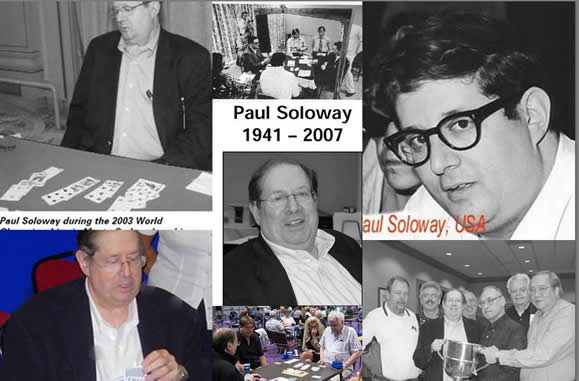
Paul Soloway (1941 – 2007)
Extracts from « Paul Soloway was so good, people paid to play with him » by Kaitlin Manry, Herald Writer Mill Creek
« Paul Soloway A Personal Remembrance « by John Swanson
« The Art of the Educated Guess by a Genial Giant of the Game » by Phillip Alder
« Friends remember Paul Soloway Daily Bulletin 4, Fall NABC 2007 » PDF
Remembering Paul Soloway on Great Bridge Links.
Paul Soloway, the ACBL’s all-time leading masterpoint holder and one of the great players of all time, died of complications from an infection on Nov. 5 at a hospital in the Seattle area. He was 66. At the time of his death, Soloway’s masterpoint holding was at 65,511.92, more than 6000 ahead of second on the list. Soloway was elected to the ACBL Bridge Hall of Fame in 2001, the first year he was eligible (minimum age of 60) and was inducted in 2002. He was a key member of the Nick Nickell team that has dominated North American and world bridge for more than a decade. He was a member of the winning Bermuda Bowl team five times, the latest in Monte Carlo in 2003. He also won more than two dozen North American championships. At his last NABC this summer in Nashville, Soloway was part of the winning squad in the Spingold Knockout Teams, his ninth win in that event. He was scheduled to play with the Nickell team in the Bermuda Bowl in Shanghai, China, this fall but his illness kept him from making the trip. Paul Soloway was cremated with a deck of world championship bridge cards in his right hand.His ashes will eternally rest in two of his coveted Vanderbilt bridge trophies. Considered the best bridge player in North America for nearly two decades, Soloway lived a fairly anonymous life in a pleasant Mill Creek cul-de-sac. In the bridge world, however, he was a giant — known to everyone and admired by many.
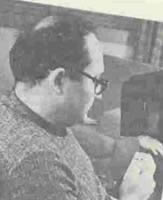
Bobby Wolff, another of the game’s great players, praised his colleague and former teammate: “Paul touched everyone in positive ways . . . He was always the same, one of the greatest bridge players ever (top five for sure), a truly fierce competitor, a wonderful and understanding teammate with a totally ethical and honest approach to the game (never seeking undue advantage), always ready to play, and one who never made excuses for anything. Yet, his life was gentle, (if Shakespeare will excuse me) but the elements so made up in him that nature might stand up and say to all the world, ‘This was a man!’ ”
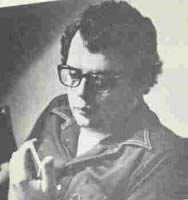
« Paul would spend two-thirds of the day in the hospital and a third of the day at the bridge table, » said his longtime partner Bob Hamman of Dallas. « We just glued him back together and sent him into battle. That’s the way he was. He was a guy who only knew one way to play and that was all out. »
His last phone call was to Hamman to let him know that he planned to play at a national tournament in November with their team. Since he couldn’t keep his body upright, he planned to play in a wheelchair with straps holding him to the chair, Pruitt said.Propped up in a hospital bed, he played bridge on a laptop computer. Too weak to press the keys, Soloway directed his wife to push them for him. Toward the end, as he drifted in and out of consciousness, he mumbled about bridge.
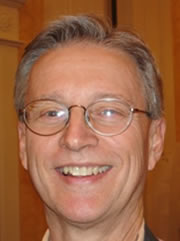
Bart Bramley met Soloway 40 years ago and when, in 1984, Bramley and his wife, Judy, decided to leave Connecticut, they chose Seattle for their new home. When they called Soloway, the only person they knew in the Seattle area, he and Pam welcomed them into their home and helped them settle in. “I will always remember Paul the host, the gentleman, the friend,” said Bramley.
« You could call him the Babe Ruth of bridge, » said Brent Manley, editor of the Bridge Bulletin. « Babe Ruth had the home run record for a long, long time and he was kind of a larger than life character. Paul was the same way. Everyone knew his face. He won so many things. » »The bridge world has lost something, » Manley said. « There just won’t be anybody like him. There’s never been another Babe Ruth since he quit playing and died. There won’t be another Paul Soloway.
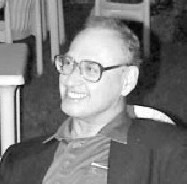
Richard Freeman was Soloway’s teammate on the Nick Nickell squad that has been so dominant for the past decade. Freeman was ill during the Summer NABC in Nashville this year and did not play in the Spingold Knockout Teams, the last North American championship Soloway won. Freeman recovered in time to rejoin the team for the Bermuda Bowl in Shanghai earlier this year. “It’s humbling to realize,” said Freeman, “that without me, the team won. Without Paul, they didn’t even make it to the quarterfinals (in Shanghai).” Freeman said he will always remember Soloway as a great teammate and a trick-taking machine. When it was time to compare with teammates in a match, Freeman said, “if Paul said, ‘We’re okay,’ you didn’t need to compare. He was the best bridge player and finest teammate I’veever run into.”
Paul Soloway ‘s Bridge Career
some extracts from Paul Soloway, a personal remenbrance by John Swanson
Soloway grew up in Beverly Hills and learned bridge from his parents. While studying business at San Fernando Valley State College, he frequently skipped class to play bridge. After six months at a « real job, » he quit and traveled the country playing bridge, hustling in bowling alleys and betting on sports games, Pruitt said. In 1962, he joined the American Contract Bridge League. Fascinated by the numbers and puzzles of the game, he quickly earned his first masterpoints. For the rest of his life, he carried the card noting those first points in his wallet. He’d sometimes show it to beginners to inspire them and prove that everyone starts on the bottom.Paul’s bridge career was an instant success.
He and Jerry Hallee won the Senior Masters title at the Los Angeles Summer Nationals in 1963. He won the Life Masters Men’s Pairs in 1965. There seemed to be at least one National title almost every year thereafter. In 1968 Paul won the McKinney trophy (later the Barry Crane Top 500). He repeated in 1969.
In 1971 Paul replaced Billy Eisenberg as a member of the Dallas Aces. The team qualified the 1972 Olympiad, Paul’s first international team competition, where they finished second to the Italian Blue Team. Paul dropped off the Aces after that year (he would rejoin twice more for short stints), but was back playing for the world title in 1973 and 1975. In 1976 Paul and his teammates finally defeated the Blue Team for the Bermuda Bowl.
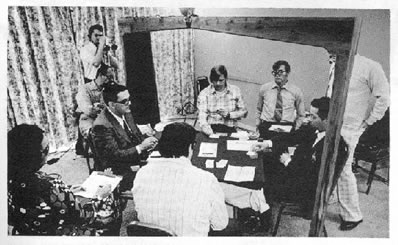
He won nearly 30 national championships and had 65,511.92 master points, more than 6,000 ahead of the next-most-successful player, Mike Passel.
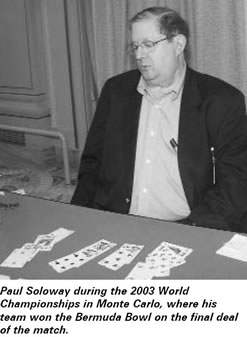
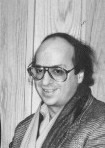
I have played with and against the best players in the world,” said Alan Sontag. “Paul was the best. John Swanson said his longtime friend Soloway was meant to play bridge. The regular job Soloway held long ago, said Swanson, “was the worst two months of his life.
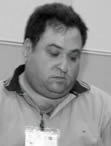
Gary Cohler recalled his first meeting with Soloway, 20 years ago at a regional. Cohler said his team played against Soloway’s in a Swissmatch, losing by a narrow margin. There was an appeal on one of the boards, Cohler said, but time was running short. Several players, including Soloway, had airplanes to catch. Cohler said he approached Soloway and told him that if Soloway would assure him that the teammates involved in the appeal had done nothing wrong, he (Cohler) would drop the appeal and everyone could go on their way. “I can’t do that,” said Soloway, who then went to inform the others they were missing their planes. I always admired him for his integrity,” said Cohler, who added, “Bridge was his passion, and few people know how hard he worked at the game.
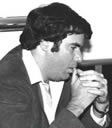
I first met Paul in 1971 when I was a long haired hippie trying to become a bridge pro.We became good friends due to mutual interests like bridge sports and the crap table.I benifitted from Pauls friendship seeing his tremendous honesty and integrity.I was priviledged to play with him on many professional teams and progressed faster than would have been possible without him.Paul was the toughest competitor in both bridge and life I have ever known.His list of ailments could have filled the Mayo clinic yet it barely slowed him down.Pauls greatest move was hooking up with Pam Pruitt Like many of us hopeless males Paul needed someone to structure his life as well as take care of him.Pam did that for him and so much more.Paul was a great champion and a great friend and the bridge world wont be the same without him.He was definitely the greatest player of my lifetime.
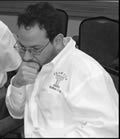
Steve Weinstein said he received an invitation to play with Soloway in a regional tournament a couple of years ago, and he accepted immediately. Weinstein said his wife was surprised because he rarely plays in regionals. Weinstein told his wife, “Paul Soloway is my bridge hero. »
Bridge was Soloway’s oxygen, according to his wife of 30 years, Pam Pruitt
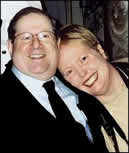
Pam Pruitt-Soloway was the late champion’s wife for more than 30 years. More than anyone else, she understood his passion for the game. He read and read all the bridge books,” she said. Pruitt said her husband was quick to recognize young talent in the bridge world, but he worried that some might take their for gifts and not work at their craft.
« Bridge was Soloway’s oxygen, according to his wife of 30 years, Pam Pruitt. »If he couldn’t play bridge, he didn’t want to live, » she said tearfully. « It was everything. It doesn’t mean that I wasn’t important, but I was secondary. »Throughout his illnesses, bridge was what kept him going, said Pruitt, 55, a stock trader and former Mill Creek mayor. For the last year and a half, as he flew around the world playing bridge, she went with him. At night, she’d connect him to a portable dialysis machine and help him through his medical regimen.Regardless of how poorly he felt, when it was time to play, he’d get on his red scooter and lose himself in the game. »He was like a fish being released into water, » Pruitt said. « He was back in his world. »Soloway met Pruitt at a bridge tournament in Eugene, Ore., in 1977. They married a short time later and he moved to Mill Creek to join her. After playing a few times in the shadow of her husband, Pruitt quit bridge, but never stopped admiring her husband’s skill and passion for the game.
At the Summer NABC in Nashville, Pruitt said, Soloway had been staying in bed trying to get his two feet to heal. When we got to Nashville, everyone said the playing area was difficult to locate. I escorted him to the playing area. Paul was on his scooter. The minute he entered the room he took off at full speed without looking back. What’s funny is when you saw the look on his face, it was sheer joy …like a caught fish being released back into the water. Paul was back where he belonged.” Recalling the Bermuda Bowl won by the Nickell team in 2000, Pruitt recalled that the tournament started 42 days after Soloway had open heart surgery.
Playing, especially with the Nickell team, was Soloway’s raison d’etre. Said Pruitt,
« I feel so lost right now. Like my best friend is moving on and we
aren’t going to be best friends any more. My best friend who was so
honest and strong, so loyal to his friends, never a gossip, a sportsman at all costs, a fierce competitor, the ultimate team player yet in so many ways an innocent in the world around him. »